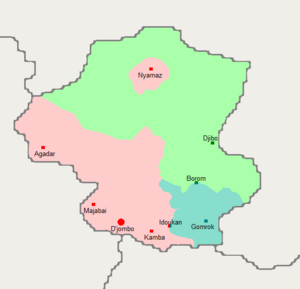Bamvangan insurgency
| Bamvangan Insurgency | |||||||
|---|---|---|---|---|---|---|---|
 Military situation in Bamvango as of 18 August 2021; Red the Bamvangan government and supportive militias, green the Bamvangan Revolutionary Government and teal the Patriotic Front-Kuol Arop | |||||||
| |||||||
| Belligerents | |||||||
|
Supported by: Supported by: | ||||||
| Commanders and leaders | |||||||
|
|
| ||||||
| Strength | |||||||
|
Bamvangan Security Forces: 150,000 (2020) Militias: 10,000+ |
Bamvangan Revolutionary Army: 45,000 PF-Kuol Arap: 30,000 | ||||||
| Casualties and losses | |||||||
|
8,674 killed (official estimates) 12,000+ (unofficial estimates) | 5,000+ killed or injured (per Bamvangan government) | ||||||
|
2,000,000+ displaced | |||||||
The Bamvangan Insurgency is an ongoing civil war in the Bamvango involving the government, rebels from the Bamvangan Revolutionary Government (BRG), and Patriotic Front-Kuol Arap (PF-KA).
The conflict has its roots in the Bamvangan Civil War from 2013-2014 when a rebel group, the Patriotic Front, rose up against the government of long-time president Abdallah Daya Ibrahim and deposed his government, creating a new government dominated by PF officials. Ibrahims core supporters fled to northeast Bamvango where his powerbase lay, with the Bamvangan government under newly elected president Anthony Benoudjita failing to dislodge rebel forces from this territory. In 2015 the rebel forces declared the creation of the BRG and launched an offensive that seized much of northern Bamvango.
In 2017 former PF leader and vice-president Oscar Kuol-Arap launched a rebellion in southeast Bamvango severely weakening the central government. A CN peacekeeping force, the Community of Nations Bamvangan Military Observer Group (GOMCONBA) alongside a deployment of Estmerish air support allowed the government to prevent the PF-KA from taking Idoukan. However in 2020 the PF-KA pushed government forces back with the BRG consolidating its control in northern Bamvango and the PF-KA in the southeast.
The conflict has displaced 2 million people and has reversed much of the social and economic progress the country made in the past decade. Reasons for the conflict include ethnic and religious tensions, a desire to control resources and the role of outside actors such as Zorasan, Estmere and Yemet. Unsuccessful peace talks in St Avelines have produced no lasting peace agreement.